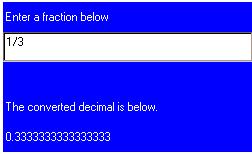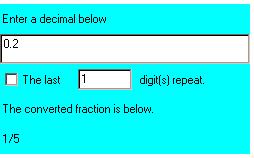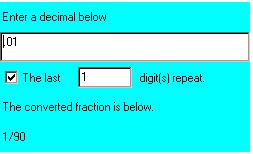What is Converter?
This activity allows the user to explore converting decimals to fractions and fractions to decimals. To convert a fraction to a decimal is easy; just divide the top number by the bottom number. The top number is called the numerator and the bottom number is called the denominator. You can do this either with a calculator or using long division.
Converting a terminating (non repeating) decimal to a fraction is a little harder. The first step is to multiply the decimal by a power of ten to move the decimal point all the way to the right. For example, if the decimal has three numbers behind the decimal place then you would multiply by a one with three zeros (1000). Now put that number over the power of 10 you multiplied by and reduce that fraction. Here is an example:

How Do I Use This Activity?
This activity allows the user to explore converting decimals to fractions and fractions to decimals.
Controls and Output
-
On the left side of the activity is a text field where you can enter a fraction. After you
press enter, the decimal equivalent will be displayed below the text field:

-
On the right side of the activity is a text field where you can enter a decimal. After you
press enter, the decimal equivalent will be displayed below the text field:

-
You can specify if your decimal has repeating digits. Check the checkbox beside the words
"The last" and enter the number of digits that repeat. Then type your decimal number in
the box and press enter. For instacnce, suppose you wanted to convert .011111111..... to a
fraction. You would check the checkbox and type "1" as the number of digits that repeat.
Then you would type .01 in the decimal entry box and press enter.

Description
This applet allows the user to explore converting decimals to fractions and fractions to decimals. This activity would work well in mixed ability groups of three or four for about thirty minutes if you use the exploration questions and five to ten minutes otherwise.
Place in Mathematics Curriculum
This activity can be used to:
- convert fractions to decimals
- convert decimals to fractions
- develop number sense
Standards Addressed
Grade 9
-
Numeration
- The student demonstrates conceptual understanding of real numbers.
Grade 10
-
Numeration
- The student demonstrates conceptual understanding of real numbers.
Fourth Grade
-
Number and Operations-Fractions
- Understand decimal notation for fractions, and compare decimal fractions.
Fifth Grade
-
Number and Operations in Base Ten
- Perform operations with multi-digit whole numbers and with decimals to hundredths.
Grades 6-8
-
Numbers and Operations
- Understand meanings of operations and how they relate to one another
Grade 6
-
Number and Operations, Measurement, Geometry, Data Analysis and Probability, Algebra
- COMPETENCY GOAL 1: The learner will understand and compute with rational numbers.
Grade 7
-
Number and Operations, Measurement, Geometry, Data Analysis and Probability, Algebra
- COMPETENCY GOAL 1: The learner will understand and compute with rational numbers.
Textbooks Aligned
6th
-
Module 5 - Creating Things
- Section 1: Comparing Fractions
7th
-
Module 1 - Search and Rescue
- Section 5: One-Step Equations
Be Prepared to
- explain why fractions add, subtract, and multiply like they do. You may want to have fractioncircles or other manipulatives to convince your students.
- explain computer rounding errors.